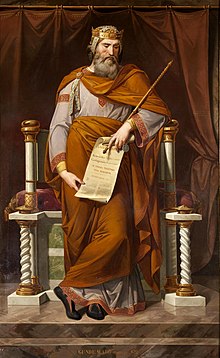Gundemar
show This article may be expanded with text translated from the corresponding article in Spanish. (July 2012) Click [show] for important translation instructions. |

Gundemar was a Visigothic King of Hispania, Septimania and Galicia (610–612).
Reign[]
Gundemar continued a policy of amity with Clotaire II of Neustria and Theodobert II of Austrasia. To this end, he sent grand sums of money to support their cause against their relative (cousin and brother, respectively) Theuderic II of Burgundy. At other times, he pursued a hostile policy against Brunhilda.[1]
According to Isidore of Seville, Gundemar made one expedition against the Basques, then besieged the Byzantines in the next. He died a natural death in Toledo, probably in February or March 612.[2] The Chronica Regum Visigotthorum records that Gundemar reigned for one year, ten months and 14 days.[3] He was succeeded by Sisebut.
He was married to Hildoara.
Legacy[]
The towns of Gondomar in Portugal and in Galicia are named after him.[citation needed]
References[]
- ^ E. A. Thompson, The Goths in Spain (Clarendon P., 1969), p. 160.
- ^ Isidore of Seville, Historia de regibus Gothorum, Vandalorum et Suevorum, chapter 59. Translation by Guido Donini and Gordon B. Ford, Isidore of Seville's History of the Goths, Vandals, and Suevi, second revised edition (Leiden: E. J. Brill, 1970), p. 27.
- ^ Chronica Regum Visigotthorum, España Sagrada Tomo II [1], p. 173.
External links[]
- (in Spanish) Coins of King Gundemar
- Visigothic kings
- Gothic warriors
- 612 deaths
- 7th-century monarchs in Europe
- 7th-century people of the Visigothic Kingdom
- European royalty stubs